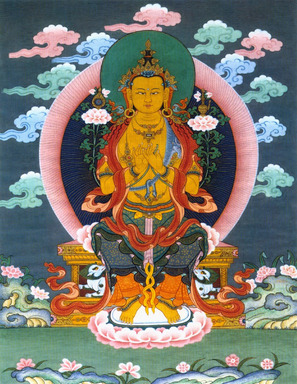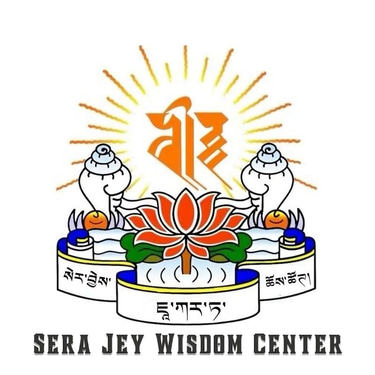Maitreya: The Future Buddha and His Importance in Buddhism
Maitreya or Metteyya, is a bodhisattva who is regarded as the future Buddha of this world in all schools of Buddhism, prophesied to become Maitreya Buddha or Metteyya Buddha.
8/11/20257 min read
Maitreya, known in Sanskrit as Maitreya and in Pali as Metteyya, is one of the most significant and inspiring figures in Buddhist thought. He is regarded as the Buddha of the future the next fully awakened being who will appear in our world to renew the Dharma and guide countless beings to liberation. In the Buddhist cosmological timeline, we are currently living in the era of Shakyamuni Buddha, the historical Buddha who attained enlightenment in India over 2,500 years ago. His teachings still exist, but according to Buddhist tradition, there will come a time when they gradually decline, eventually disappearing entirely from human memory. At that point, the world will enter an age of spiritual darkness, ignorance, and moral decay. It is in that future time that Maitreya will descend from his current abode, attain Buddhahood, and once again set the Wheel of Dharma into motion. The very name “Maitreya” derives from the Sanskrit word maitri — meaning loving-kindness, benevolence, or friendliness reflecting the compassionate nature he will embody.
The concept of Maitreya has roots in the earliest layers of Buddhist tradition, appearing in both Theravāda and Mahāyāna texts. In the Cakkavatti Sīhanāda Sutta of the Pali Canon, Maitreya is prophesied as the next Buddha who will arise when human beings once again live long, virtuous lives after an extended period of degeneration. In Mahāyāna scriptures, such as the Maitreyavyākaraṇa (The Prophecy of Maitreya), the description of his coming is enriched with vivid details about the conditions of the world at that time, his pure land, and the scope of his compassionate activities. Despite variations between traditions, all agree that Maitreya’s role is to renew the Dharma and restore harmony to a suffering world. This shared belief across Buddhist schools demonstrates how deeply his image resonates as a symbol of hope, renewal, and unshakeable compassion.
According to traditional accounts, Maitreya is presently a bodhisattva — an awakened being who has vowed to delay his final enlightenment until the time is ripe to benefit the greatest number of beings. He currently resides in Tusita Heaven, one of the heavenly realms in Buddhist cosmology. The Tusita realm is said to be the abode of bodhisattvas who are destined to become Buddhas, and it is where they perfect the remaining qualities needed for their final birth as fully awakened beings. In this realm, Maitreya continues to teach celestial beings and prepare for his future mission on Earth. Life in Tusita is vastly different from life in the human realm; it is free from the coarse sufferings of our world, filled instead with joy, harmony, and subtle pleasures. Yet, despite the comfort of this abode, Maitreya’s gaze is always turned toward our world, awaiting the time when his compassionate vow will call him to descend and guide beings once more.
The circumstances of Maitreya’s future coming are described in detail in Buddhist literature. After the passing of Shakyamuni Buddha, it is said that the Dharma will remain for a certain period, upheld by sincere practitioners. However, as the centuries pass, moral conduct will decline, spiritual understanding will fade, and the Dharma will gradually vanish. This process of degeneration is a central feature of Buddhist cosmology the cycle of arising, flourishing, decline, and disappearance. Eventually, human lifespans will become extremely short due to the intensity of greed, hatred, and delusion in the world. Violence, injustice, and suffering will dominate society. In this darkest age, when the memory of the Buddha’s teachings has been completely lost, Maitreya will appear. His very presence will bring about a turning point in human history, initiating a new age of peace, morality, and spiritual growth.
When Maitreya is reborn into the human world, the conditions will already be shifting toward improvement. Buddhist tradition holds that human lifespans will have begun to lengthen again, and a sense of harmony will start to return to society. In this auspicious environment, Maitreya will undergo the stages of awakening in much the same way as Shakyamuni: he will be born into a human family, encounter the realities of suffering, and seek the path to liberation. Through deep meditation and insight, he will attain full enlightenment under the Bodhi tree. Following his awakening, he will turn the Wheel of Dharma, teaching the Four Noble Truths and the Eightfold Path anew, as well as skillful methods appropriate for the beings of that age. His Dharma will be perfectly suited to the mental capacities, cultural background, and karmic tendencies of the people in that future time, ensuring that countless beings can benefit from his guidance.
One of the most inspiring aspects of Maitreya’s story is the meaning of his name and the qualities it represents. Maitri, or loving kindness, is one of the Four Immeasurable Minds in Buddhism alongside compassion (karuna), sympathetic joy (mudita), and equanimity (upekkha). Maitreya’s very identity as “The Loving-Kind One” signals that his teachings will be rooted in boundless friendliness toward all beings. In a world that has been through cycles of moral collapse and rebirth, his gentle yet profound approach will serve as a healing balm, restoring trust, harmony, and ethical integrity. In many ways, Maitreya’s role is not just to teach the Dharma intellectually but to embody it so completely that his presence itself is transformative. His compassion will be felt by all, his patience will be limitless, and his guidance will lead both ordinary people and advanced practitioners toward liberation.
In Mahāyāna Buddhism, Maitreya’s significance is expanded further. He is not only the future Buddha but also an active bodhisattva accessible to devotees even now. In this view, Maitreya can be approached through prayer, meditation, and devotional practices, with the belief that he can offer guidance, inspiration, and blessings in the present life. Some practitioners aspire to be reborn in Tusita Heaven alongside Maitreya, so they can learn directly from him before accompanying him back to the human realm during his final life. Mahāyāna texts describe Maitreya’s celestial form and pure land in vivid detail, painting a vision of a realm filled with teaching, joy, and the constant presence of Dharma. In these descriptions, Tusita is not merely a distant heaven but a real and attainable destination for those who cultivate virtue, faith, and wisdom.
The image of Maitreya has also been influential in Buddhist art and culture across Asia. In early Indian and Gandharan art, Maitreya was often depicted as a princely bodhisattva, adorned with fine garments and a water flask, a symbol of spiritual refreshment. As Buddhism spread to China, Korea, Japan, and beyond, the depictions of Maitreya evolved to match local artistic styles and cultural understandings. In Chinese Buddhism, Maitreya became associated with the figure of the “Laughing Buddha,” or Budai, a rotund, cheerful monk carrying a cloth sack. This image, though historically separate from the original bodhisattva concept, merged with the popular devotion to Maitreya, symbolizing generosity, contentment, and joy. In Tibetan Buddhism, Maitreya is often depicted seated on a throne, his feet resting on the ground or on a small footstool, a posture indicating that he is ready to rise and begin his descent to the human realm at any moment. In Southeast Asia, particularly in Myanmar and Thailand, Maitreya is revered as a source of hope for a better future, with statues and paintings reminding devotees of the promise of renewal.
Throughout history, Maitreya’s prophecy has also inspired movements and interpretations beyond mainstream Buddhism. In times of social upheaval, political unrest, or moral decline, individuals and communities have looked to the idea of Maitreya as a source of reassurance that change will come. In some historical periods, the belief in Maitreya’s imminent arrival has even fueled reform movements or millenarian uprisings, as people sought to align themselves with what they saw as the coming new age. While such interpretations vary in their fidelity to traditional doctrine, they highlight the enduring psychological and cultural power of Maitreya’s image: the idea that no matter how dark the times, a new dawn of wisdom and compassion is on the horizon.
The importance of Maitreya in Buddhism can also be understood through the lens of personal practice. Even though his physical arrival is believed to be far in the future, the qualities he embodies — loving-kindness, compassion, and a commitment to the welfare of all beings — are qualities that practitioners are encouraged to cultivate here and now. In this sense, Maitreya is both a future savior and a present role model. By emulating his qualities, one contributes to the creation of conditions in the world that will make his future Dharma flourish. In Mahāyāna and Vajrayāna traditions, meditation practices focusing on Maitreya involve visualizing him in Tusita Heaven, reciting prayers or mantras, and making aspirations to meet him in the future. These practices strengthen the practitioner’s connection to Maitreya and inspire a daily life rooted in loving-kindness.
In Tibetan Buddhism, Maitreya is also associated with a set of five treatises known as the “Five Treatises of Maitreya,” said to have been transmitted to the Indian master Asanga during a visionary journey to Tusita Heaven. These works, which include important Mahāyāna philosophical texts such as the Abhisamayālaṅkāra and the Mahāyānasūtrālaṅkāra, have been foundational in shaping Buddhist thought on the nature of reality, the path to enlightenment, and the qualities of a Buddha. Whether one takes these accounts literally or symbolically, they underscore Maitreya’s role not only as a future teacher but also as an active source of wisdom in the present age.
From a symbolic perspective, Maitreya’s place in the Buddhist timeline serves as a reminder of the cyclical nature of history and spiritual life. Just as the Dharma flourished under Shakyamuni and will do so again under Maitreya, it is natural for teachings and practices to undergo cycles of rise, decline, and renewal. On a personal level, practitioners may experience their own cycles of enthusiasm, stagnation, and renewal in their spiritual journey. In this way, Maitreya can be seen as a mirror for the inner process of reawakening, encouraging practitioners to trust in the possibility of starting fresh no matter how far they feel they have drifted from the path.
For modern Buddhists, Maitreya’s message is especially relevant in a world facing rapid technological change, environmental crises, and social challenges. The qualities he represents — compassion that extends beyond boundaries, patience in the face of difficulty, and the commitment to serve others selflessly — are as needed today as they will be in his future era. While we may not live to see Maitreya in the flesh, we can bring his spirit into our communities by fostering kindness, promoting understanding, and working toward harmony. In this way, the prophecy of Maitreya becomes not a distant dream but a living influence on how we act in the present.
In conclusion, Maitreya occupies a unique and vital place in Buddhist thought. He is the bridge between the age of Shakyamuni and the future flourishing of the Dharma, the embodiment of loving-kindness, and a source of hope for all beings. His story reminds us that the Dharma is never truly lost — that even in times of darkness, the seeds of wisdom and compassion are preserved, ready to bloom again when conditions are right. Whether we view him as a distant figure who will arrive in the far future, a living bodhisattva in Tusita Heaven, or a symbolic ideal to be cultivated now, Maitreya’s presence in the Buddhist tradition serves as a profound reminder of the inexhaustible compassion of the Buddhas and the ever-renewing possibility of awakening.


Community
Explore teachings, prayers, and cultural events.
Address
Sera Jey Wisdom Center
Ruko Savoy Blok C1 No.31 & 32,
River Garden Jakarta Garden City,
Cakung Timur, Jakarta Timur 13910,
Indonesia
+62 813 2488 4241
© 2025. All rights reserved.
